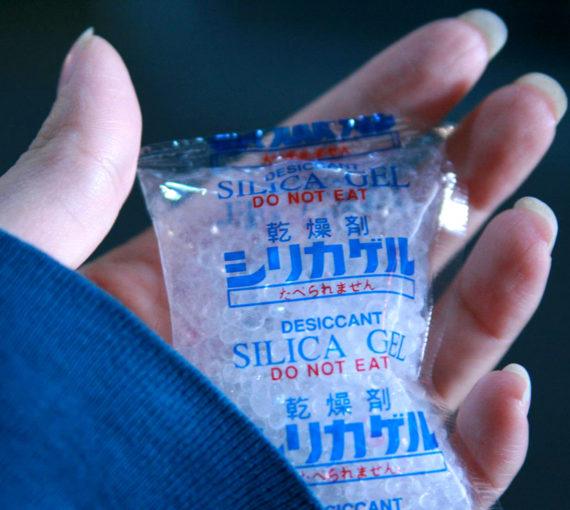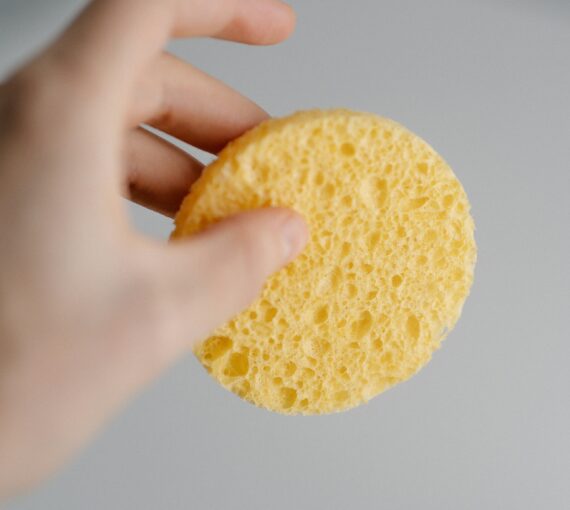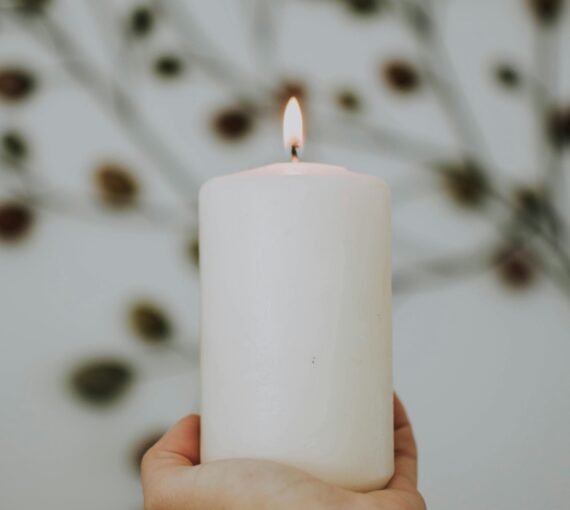
Hang dry towels and cloths thoroughly after washing. Sun drying produces organic compounds that human noses associate with pleasant plant scents!
Who doesn’t want to live in a fresh-scented space? Towels and cloths, shoes, kitchen sponges, carpets and upholstered furniture, compost, garbage bins and refrigerators are notorious for harbouring stubborn smells.
Try these eco-friendly methods to deodorize common items — even make your own air freshener. You’ll avoid toxic products, extend the life of your stuff, save money and reduce your environmental impact.
A healthy environment starts at home!
How to deodorize six common items
1. Towels and cloths
Ever get out of the shower or bath squeaky clean and the minute the towel hits your skin you think “What’s that stench? I just washed this!”
Towels and cloths are designed to absorb water, so they stay damp for extended periods, giving bacteria, mildew and mould a perfect place to thrive.
Try these eco-friendly methods to deodorize towels and cloths — even avoid stink in the first place:
- Choose bamboo. Bamboo towels are better for odour prevention. Why? Bamboo is made of a stringy, breathable material. It tends to be lighter than cotton and dries faster. Bamboo plants are also thought to be naturally resistant to bacteria, mildew and fungus. Research your purchases! Choose products manufactured using environmentally friendly processes. (Note: organic cotton can perform just as well when you follow all these tips. Hemp is another option.)
- Hang to dry. Dry towels and cloths thoroughly after washing. Let them “breathe” immediately after each use to allow air flow through fibres and speed drying time. Even better: line dry them outside. Sun drying produces organic compounds that human noses associate with pleasant plant scents — a naturally occurring “fresh laundry” smell.
- Use a dryer wisely. Don’t overstuff it. Use wool dryer balls to absorb moisture, separate layers of fabric when tumbling, stimulate airflow and shrink drying time. Option: A few drops of essential oil onto wool dryer balls will infuse your laundry with fragrance. Remember: dryers are energy hogs. Air dry or use the dryer’s air cycle whenever you can.
- Avoid bleach and softeners. Bleach destroys the softness of towels and fabric softener leaves a coat of chemicals behind.
- Run a wash cycle with vinegar. Run your stinky towels and cloths through a regular wash cycle with half a cup of vinegar as a natural fabric softener and deodorizer. (Check manuals first. Vinegar can be problematic for some appliance components.)

Tip!
Got towels and cloths that are beyond deodorizing? Donate them to an animal shelter or rehabilitation centre or give them to a mechanic or local auto repair shop.
2. Shoes
Stinky shoes are an unfortunate reality. But many commercial shoe deodorizers contain chemicals like formaldehyde and phthalates that can cause skin irritation and respiratory issues.
Before tossing smelly footwear, try refreshing and deodorizing them using these easy, eco-friendly DIY tips:
- Wear socks or stockings. Comfortable socks and stockings protect feet, control moisture and regulate temperature. They also create a barrier between your foot and the shoe, absorbing sweat and reducing odours. They’re easier to clean, deodorize and replace than shoes. Socks made entirely of natural fabrics (i.e., cotton, wool, etc.) absorb odours better than most synthetics.
- Don’t let shoes pile up. Organize your shoes so they can breathe. Take athletic shoes out of the gym bag between workouts (likewise with ice skates, dance shoes, cleats, etc.). Decluttering closets and drawers can help extend the life of shoes and clothing.
- Freeze shoes. Bacteria need a warm and dark place to thrive. Pop shoes in a used plastic bag and leave them in the freezer overnight. The cold air will help kill bacteria and stop odour from getting worse.
- Baking soda. Leave a teaspoon of baking soda inside shoes overnight to absorb unpleasant smells. Repeat as needed.
- Cedar deodorizers. Cedar wood absorbs moisture and keeps shoes fresh between uses. Many shoe retailers sell cedar balls, chips or inserts. You can even use cedar wood essential oil to refresh cedar wood balls, chips or inserts or put a few drops on a cotton ball.
- Reuse silica gel packs. Before tossing silica gel packs found in most packaging, throw them in your shoes! Silica gel absorbs excess moisture and odour, helping keep shoes fresher for longer. (Pop them in your gym bag too!)
- Tea and coffee. That’s right! Try placing a fresh tea bag or dried used coffee grounds (in a sealed cloth pouch, stocking or cheesecloth) in shoes, gym bags, closets and drawers. They soak up musty odours and disperse a fresh scent.
- Spritz with vinegar. Mix equal parts white vinegar and water in a spray bottle. Spray into the inside of the shoe and allow it to dry fully. (Use caution with leather and suede to avoid damage.)
- Sun and fresh air. Leave shoes on a balcony, windowsill or anywhere where direct sunlight and fresh air can reach them. The fresh air can help diffuse odour. The sun’s UV rays can help kill bacteria!

De-stink with silica gel packs
Don’t throw out silica gel packs found in packaging! Instead, reuse them to combat excess moisture. Perfect for de-stinking running shoes, gym bags and hockey gloves.
3. Kitchen sponges
Microorganisms thrive in damp places. Kitchen sponges are a perfect breeding ground for bacteria, mildew and mould. The result? A musty, sour smell.
Depending on your use, studies say to replace kitchen sponges every two weeks or so to prevent bacteria buildup that can make you sick, but you may notice a smell after only a few washes. Tossing stinky kitchen sponges regularly leads to a lot of (plastic) waste.
Eco-friendly methods to deter microbes and deodorize and clean kitchen sponges:
- Soak and scrape before sponging. Soak sticky plates, pots and pans and then remove food residue with a broad bristle brush or scraper that’s easier to keep clean. Use your kitchen sponge only for the final soaping and rinsing. This will prevent food particles from getting stuck in the sponge and smelling it up as they decompose.
- Dry thoroughly between uses. Avoid letting your sponge sit in stagnant water. Use a sponge holder that allows water to drain and air to flow.
- Sanitize with hot water. This is most effective when sponges first begin to smell. Boil water and pour over the sponge. The hot water dissolves oils, kills bacteria and mould spores, and eliminates odour. Once cooled, wring out excess water and air dry.
- Soak in a solution of equal parts white vinegar and water. Keep the sponge fully submerged for about an hour. Rinse thoroughly. Air dry.
- Make a baking soda deodorizer. Mix four tablespoons of baking soda in two cups of warm water. Let the sponge absorb the solution and leave it for a few hours. Rinse thoroughly. Air dry.

Choose Earth-friendly sponges
Many conventional sponges are made of plastics like polyurethane and polyester which can’t be recycled and don’t biodegrade. Synthetic sponges play a major role in microplastic pollution. Tiny particles frequently wash down drains and enter the environment.
Choose sponges made from biodegradable, renewable materials:
- Bamboo. Sponges made from bamboo fibres are naturally antibacterial and biodegradable. They often contain other Earth-friendly materials for added durability.
- Cellulose. Sponges made from wood pulp are biodegradable, compostable and free from synthetic dyes and chemicals.
- Coconut husk. Sponges made from coconut fibres are durable and biodegradable. They often contain cellulose for better absorbency.
- Loofah. Sponges made from the fibrous interior of the loofah plant are compostable. They’re rough and tough so perfect for scrubbing but won’t scratch surfaces.
- Hemp. Sponges made from hemp fibres are durable, naturally antibacterial and biodegradable.
- Sea sponge. Harvested from the ocean, sea sponges are biodegradable, highly absorbent, long-lasting and gentle on surfaces. Purchase from companies that harvest sustainably.
4. Carpets, rugs and upholstered furniture
Trapped dirt and dust, spills and stains, pet accidents, moisture and mould and/or poor ventilation can leave unpleasant odours in carpets, rugs and upholstered furniture.
Instead of using a harmful commercial cleaning solution, deodorize and refresh your carpets, rugs and upholstered furniture with eco-friendly alternatives:
- Clean spills and stains immediately. The longer they sit, the harder they (and their smells) are to remove.
- Aerate. Expose stuff to fresh air. Place furniture in a well-ventilated area, e.g., covered balcony, garage or carport, before bringing it back inside. If you can’t move it outside, crack open a window (weather permitting) while the heat and A/C are off (to avoid energy loss).
- Baking soda. Sprinkle a generous amount over the affected item. Let sit for several hours or overnight to absorb odours and moisture. Vacuum thoroughly to remove the baking soda and trapped smells.
- Steam clean with vinegar. Use a steam cleaner with equal parts vinegar and water. The heat from the steam helps kill bacteria and remove odours. Avoids harsh chemicals found in commercial steam cleaner solutions.
- Castile soap. Mix a quarter cup of castile soap with one cup of water in a spray bottle. Use for spot treatment. Dry thoroughly.
- Regular maintenance. Frequent vacuuming keeps dirt, dust and debris from accumulating and causing odour. It also helps keeps you and your family safe from exposure to toxic substances found in dust.
5. Garbage and compost bins
Garbage and compost bins can develop unpleasant odours quickly due to decomposition of organic materials, poor ventilation, moisture and residual waste. These smells and spills can also attract “pests” like flies, cockroaches and ants.
Tip! Warmer weather can significantly increase the intensity of these odours, so clean and deodorize your bins more frequently in spring and summer months.
Eco-friendly methods to minimize foul kitchen odours:
- Learn indoor composting do’s and don’ts.
- DIY bin liners. Line the bottom of garbage bins with recycled newspaper or paper scraps to absorb moisture and catch spills. Replace regularly.
- Activated charcoal. Place activated charcoal briquettes or bags (see DIY charcoal air freshener recipe below!) in the bottom of the bin to neutralize odours. Replace every few months.
- Citrus peels. Get the most from your food scraps! Pat dry and place citrus peels at the bottom of the bin to absorb smells and add a pleasant scent.
- Regular maintenance. Regularly clean garbage and compost bins with a mixture of water, white vinegar and baking soda. Scrub the interior and rinse thoroughly to remove any residue and bacteria. If possible, let the bins dry in direct sunlight to reap the natural antibacterial properties of UV rays.
6. Refrigerator
Spills, spoiled food, bacteria growth and lack of air circulation can make a fridge smelly.
Eco-friendly methods to minimize refrigerator odours:
- Regularly empty and clean thoroughly. Use an eco-friendly all-purpose cleaner. Note what needs to be eaten first to avoid food waste.
- Store food properly. Label and date food items to keep track of their freshness. Store strong-smelling foods in airtight containers to prevent odours from spreading.
- Baking soda. Place an open box or bowl of baking soda on a shelf. It helps neutralize acidic and basic odour molecules, absorbing smells.
- White vinegar. Mix equal parts white vinegar and water in a spray bottle. Use this to wipe down interior surfaces, including shelves and drawers.
- Coffee grounds. Place a bowl or jar of used, dried coffee grounds in the refrigerator. They smell nice and absorb other odours.
Environmentally friendly air freshening techniques
These environmentally friendly air freshening solutions are perfect for small spaces prone to developing odours (e.g., bathroom, mudroom, kitchen, closets, etc.).
Ensure good ventilation
Plentiful fresh air is essential for good health. Take steps to protect your indoor air.
Use exhaust fans and open vents, windows and doors to improve air circulation. Ventilate during and after activities that create odours. Try placing an electric fan near windowsills facing outward to blow air out. Or create a cross breeze by strategically placing one fan to blow fresh outdoor air into your space while another pushes smelly indoor air out.
Heaters, air conditioners and fans all use energy. Open windows only when heating and cooling systems are turned off, and only run fans when necessary.
Diffuse essential oils
Essential oils are great for eliminating unpleasant odours, introducing pleasant ones — even attacking bacteria that caused the stink. (Try them in body care recipes, too!)
Bonus: Calming essential oils promote stress relief and better sleep quality.
Use a diffuser (e.g., nebulizing, reed, ultrasonic, heat, etc.) or make your own! Add a few drops of essential oil to a teaspoon of baking soda on a dish. Leave it near an area prone to smells. Replace daily.
Some popular essential oils for odour control: lemon, myrtle, eucalyptus, lavender, lemongrass and tea tree.
Remember, when using essential oils:
- Purchase from a local distiller (or learn how to do it yourself).
- Buy organic.
- Use sparingly, with deep care and reverence.
- Follow instructions carefully — they’re potent.
Use essential oils with caution if you’re pregnant or have health issues. Always test a small amount first and omit if sensitive to scents. If you have pets, make sure to research if the oil is safe for use around animals.

What about scented candles?
Scented candles may create ambiance, but they only mask smells, not eliminate them.
Whether they’re made from paraffin or soy, all candles give off soot and volatile organic compounds, contributing to indoor air pollution.
To minimize indoor air pollution and potential irritation from candle emissions, avoid direct inhalation, only use in well-ventilated spaces and choose candles that are:
- Unscented and/or fragrance-free.
- Uncoloured.
- Made of soy, beeswax or coconut wax.
Avoid candles made of paraffin, a petroleum byproduct. It’s chemically bleached and creates highly toxic benzene and toluene (known carcinogens) when burned.
Make a stovetop simmer pot
Simmer pots are a great way to use food scraps, refresh indoor air and create a cozy ambiance. Perfect for when you’re having guests over and/or hosting planet-friendly events!
To make one, add all ingredients to a pot of water and let it simmer to release fragrances. It can be left for several hours. Be sure to add water as needed to avoid burning.
The mixture releases the food scraps’ non-toxic oils and pleasant aromas, neutralizing unpleasant odours.
Tip: If you’re already cooking and baking, place your simmer pot on the back burner to make use of residual heat and conserve energy.
Common simmer pot ingredients:
- Citrus peels. Orange, lemon, lime and grapefruit peels add a bright, fresh scent.
- Apple cores and peels. Provide a sweet, comforting aroma.
- Herbs. Rosemary, thyme and mint offer refreshing, earthy notes.
- Spices. Cinnamon sticks, cloves and star anise add warmth and depth.
Make a DIY charcoal air freshener
Activated charcoal is treated with oxygen at high temperatures to create millions of tiny spaces between the carbon atoms. These draw in and remove odours, allergens and pollutants from the air.
To make your own, you’ll need:
- High-quality activated charcoal granules or powder.
- An old, clean cloth, jute bag pouch, breathable material or mason jar with a cheesecloth-covered lid.
Put a few tablespoons of activated charcoal into your vessel. Place it in any area that needs odour-absorbing assistance. Great for small rooms, refrigerators, shoes, cars and closets.
Invest in an air purifier
If you still can’t get rid of smells, consider an air purifier if you can afford one.
It will help improve your indoor air quality by removing airborne volatile compounds. It will also help trap odours in a filter.
Avoid air purifiers that generate ozone, which can cause health problems.
E-waste is one of the fastest growing domestic waste streams, so plan to maintain and use your air purifier for its entire life. Because they use energy, only run them when necessary.



